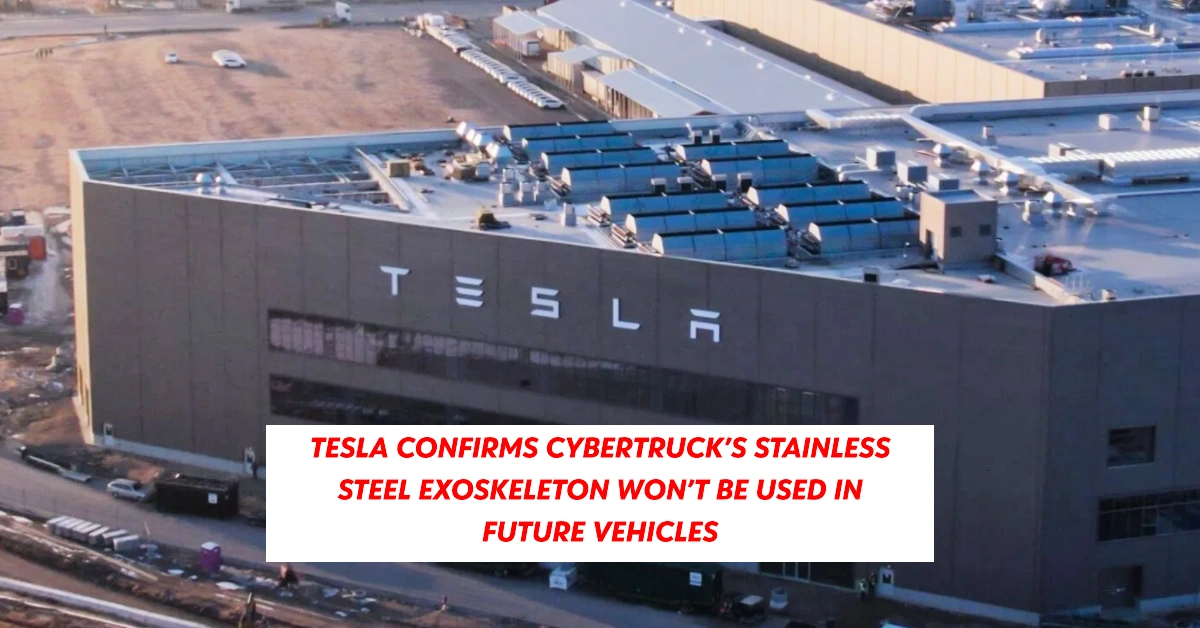In a surprising announcement, Tesla has confirmed that the stainless steel exoskeleton and advanced manufacturing process used for the Cybertruck will not be adopted in any future Tesla vehicles. Despite the innovative design and engineering breakthroughs, Tesla has decided that conventional construction materials will be used for upcoming models.
However, in a significant production milestone, Tesla also revealed that 4680 battery cell production has ramped up to support 130,000 Cybertrucks per year—ensuring that battery supply is no longer a bottleneck for the futuristic truck.
These key details were revealed in Tesla’s 2024 earnings report and Investor Deck, where the company highlighted several technological advancements from the Cybertruck that will be used in future vehicles, while retiring others.
Table of Contents
Tesla Moves Away From Stainless Steel for Future Vehicles
When the Cybertruck was first announced, many assumed that Tesla would adopt the stainless steel exoskeleton across its lineup, given its high durability, unique aesthetic, and corrosion resistance.
However, Tesla has now officially ruled out using the Cybertruck’s cold-rolled stainless steel body or its accompanying air-bending manufacturing process in future models.
📌 Key Features of the Cybertruck’s Stainless Steel Exoskeleton:
✔ Carries crash loads and increases torsional stiffness.
✔ Iconic visual design with high dent and corrosion resistance.
✔ Reduces concerns over daily wear and tear.
🚨 Why Won’t Tesla Use It in Future Vehicles?
Tesla has not provided an official reason, but industry experts speculate that:
✔ Manufacturing complexities → Stainless steel is harder to shape and weld than aluminum or traditional steel.
✔ High production costs → The specialized air-bending process requires unique tooling.
✔ Weight concerns → While strong, stainless steel is heavier than alternative materials, impacting efficiency.
Instead of using stainless steel, Tesla will incorporate several other Cybertruck technologies into future vehicles, including:
✔ Steer-by-wire system
✔ Rear-wheel steering
✔ 48-volt low-voltage architecture
✔ 800-volt high-voltage architecture
✔ Bi-directional charging
✔ Integrated audio with body structure
✔ Ethernet loop communication
These innovations will likely improve efficiency, driving dynamics, and energy management across Tesla’s future lineup.
Tesla Issues Recall for 694,000+ Vehicles Over Tire Pressure Warning Issue: What You Need to Know
Ducati Issues Recall for 2025 Panigale V4 Motorcycles Over Rear Brake Failure Risk
Tesla’s 4680 Battery Production Reaches Major Milestone
While the stainless steel exoskeleton may be a Cybertruck-exclusive feature, Tesla has confirmed a significant ramp-up in 4680 battery production.
📌 4680 Battery Cell Production Update:
✔ Now producing enough batteries for 130,000 Cybertrucks per year.
✔ Giga Texas production capacity maxed out at 125,000 trucks annually.
✔ Battery supply is no longer a limiting factor for Cybertruck production.
For years, battery availability was a rate-limiting factor in Tesla’s production plans. However, with 4680 production now at full capacity, Tesla can fully scale Cybertruck manufacturing without battery shortages slowing things down.
Is the Cybertruck Hurting Model S and Model X Sales?
Despite increased Cybertruck production, Tesla’s overall sales numbers for premium models remain stagnant.
📌 Tesla’s “Other Model” Sales Breakdown:
✔ Q4 2024 Deliveries → 23,640 units (Model S, Model X, and Cybertruck combined).
✔ Q4 2023 Deliveries → 23,000 units (before Cybertruck production ramped up).
✔ Production Capacity → Tesla can produce 225,000 units annually across these three models, but sales are well below that figure.
This suggests that Cybertruck sales may not be bringing in new Tesla buyers, but instead are cannibalizing sales of the Model S and Model X.
🚨 Why Is This a Concern?
✔ Tesla expected the Cybertruck to create new demand—but instead, sales haven’t increased overall.
✔ Premium Tesla buyers may be switching to the Cybertruck instead of the Model S or Model X.
✔ The Cybertruck is not significantly boosting Tesla’s total unit sales, despite its production ramp-up.
With Tesla now capable of producing 125,000 Cybertrucks annually, the company must find ways to increase demand to fully utilize its production capacity.
Over 317,000 Ram HD Trucks Recalled for Serious Braking System Issue: What You Need to Know
Jeep Recall Alert: Over 63,000 Cherokees Could Roll Away or Lose Power
Revolutionary Invention Turns Plastic Waste into Home Energy – No Solar Panels Needed!
Final Thoughts: What This Means for Tesla’s Future
📌 Tesla confirms that the Cybertruck’s stainless steel exoskeleton and air-bending manufacturing process will not be used in future models.
📌 Cybertruck battery supply is no longer a bottleneck, with 4680 production ramped up for 130,000 trucks per year.
📌 Despite Cybertruck production ramping up, Tesla’s “Other Model” category sales remain flat, suggesting potential cannibalization of Model S and X sales.
🚀 Looking Ahead:
✔ Will Tesla find new markets for the Cybertruck, or will sales remain limited to existing Tesla buyers?
✔ Will the retirement of the stainless steel exoskeleton mean a shift back to more traditional designs?
✔ How will Tesla balance premium vehicle demand with its expanding model lineup?
With Tesla’s 2025 roadmap taking shape, all eyes are on how the company leverages Cybertruck technology in future models—while ensuring that sales growth continues across its entire lineup.
